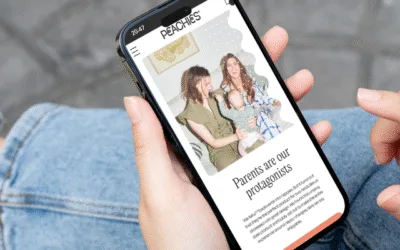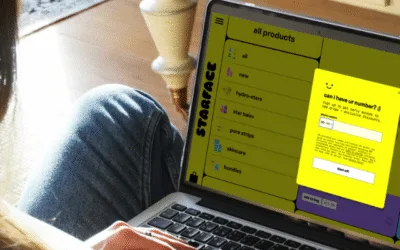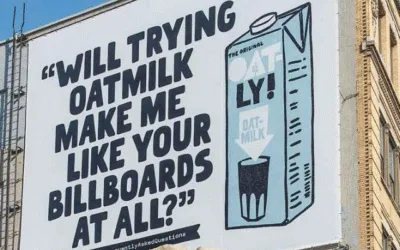Peachies beat Pampers by selling sleep, not nappies. Learn their Ladder of Why messaging trick to make your copy resonate.
Don’t worry, be happy: How feel-good copy can win over more customers
Customers are twice as likely to engage with positive messaging than negative framing. Use that to your advantage when you're writing copy.

Get pro copy tips, branding tricks and e-comm insights directly to your inbox every Tuesday.
💡 This week’s big idea
Did you know that customers are twice as likely to engage with positive messaging than fear-based or negative framing?
A study in the International Journal of Communication found that positive framing — AKA, highlighting benefits instead of problems—leads to more trust, higher recall, and increased purchase intent.
In other words, when shoppers have positive thoughts associated about a product, they’re more likely to buy it. But if a customer dwells on pain points for too long, they’re more likely to bounce.
If you do a quick Google search for how to write copy for your store, you’ll no doubt come across everybody’s favourite copywriting formula: P-A-S or Problem-Agitate-Solution.
Basically, it’s been common wisdom among wordy folk for decades — since the days of the real life Don Drapers — that your goal as a copywriter is to find your customers’ pain points, do some good ol’ shit stirring and then present your product as the solution to that pain you just agitated.
It all comes from that old school, direct response era copywriting where the goal is to grab attention and make the sale all in one interaction.
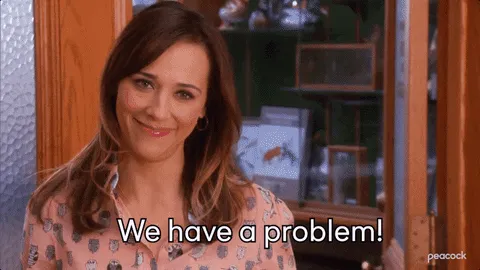
The problem is, that doesn’t work anymore.
(Well, not in e-commerce at least. It still works in other industries.)
Here’s why 👇️
👉️ Copy that focuses on the negative too much can feel manipulative and obviously trying to sell something. And if you’re anything like us, this is more likely to trigger something called reactance, a psychological pushback where we resist being persuaded simply because we feel like we’re being persuaded.
👉️ A 2023 study found that even using negative framing to highlight the positive of a product — for example, saying a sunscreen prevents skin cancer — requires the user to imagine the negative scenario. (In this case, having skin cancer.)
And by studying mouse movements and checkout rates of a test group, the study discovered that even the presence of refuted negative imagery can stop users from purchasing.
👉️ On top of that, positive language has been found to trigger the release of dopamine, which gives us feelings of pleasure and motivation. AKA, when we see positive language, we’re more receptive to taking action and clicking that buy button.
👉️ On the other hand, negative copy doesn’t just trigger a stress response. It also has a knock on effect on conversion rates, with the frequency of negative words having a direct correlation to lower conversion rates for e-commerce stores.
How to use positive framing to sell more stuff
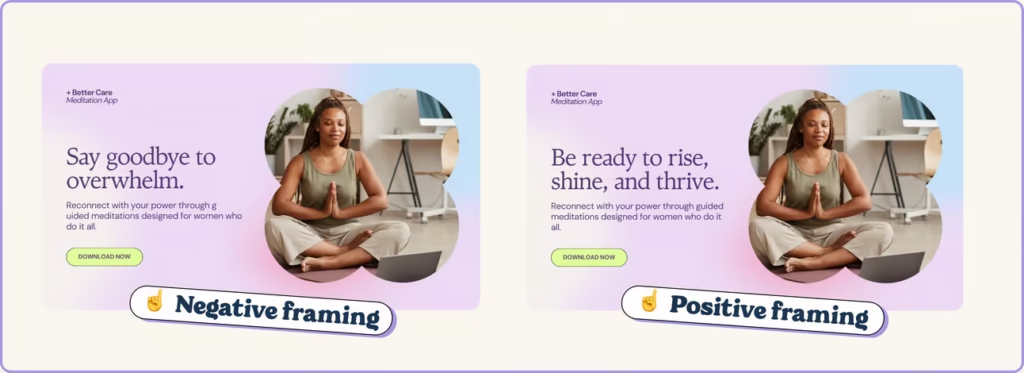
Although Problem-Agitate-Solution is becoming less effective, there is no denying that presenting your products as the solution to a problemworks.
So how do we get the same result without having to go all Wolf of Wall Street on our customers?
1. Assume the customer is already well aware of the problem you’re solving
Let’s say you’re an eco-brand selling bamboo toothbrushes. You don’t need to make them feel guilty or worried about the planet. Instead, you can position your brand as being part of the solution.
Like this 👇️
❌ Plastic toothbrushes are polluting our planet. Every year, billions of plastic toothbrushes end up in landfills and oceans, taking centuries to decompose. With every brush, more plastic waste piles up, harming marine life and fueling the climate crisis. But it doesn’t have to be this way. Switch to our 100% biodegradable bamboo toothbrush and stop adding to the problem. The planet needs change—starting with your daily routine.
✅ A small switch, a big impact. Every time you brush with our 100% biodegradable bamboo toothbrush, you’re making a choice that’s better for the planet. Sustainable, stylish, and naturally antimicrobial, it’s an effortless way to reduce waste while keeping your smile bright. Join the movement towards a cleaner future—because even the smallest swaps make a difference
👆️ See how they’re both talking about climate change, but the second one doesn’t encourage the reader to imagine landfills and a burning planet? Instead, they trust the customer knows the problem and wants to be part of the solution.
2.Keep your messaging framed on what they’re gaining
You’re not solving stress, you’re selling zen. You’re not helping them avoid hangovers, you’re selling a buzz you can enjoy every day…
This keeps them focused on the positive messaging while allowing them to fill in the blanks.
3.Use empowering language as much as possible
Empowering language shifts your customers’ attention from a place of fear and guilt to a place of agency and action. Not only does this keep them focused on the positive messaging, but it builds much stronger brand loyalty and repeat orders too.
An update to P-A-S: Picture, Amplify, Show ✊
Now for a wee bit of nuance…
Even though we now know that negative framing doesn’t work… sometimes, you are going to want to highlight how you’re better than your competition.
And in those moments, the Problem-Agitate-Solution formula is double-handy. Why? Because not only does it let you present your product as a solution, it bakes in a bit of storytelling and narrative too.
But it’s hard to do that without falling into the negative language trap.
So we gave it an update 👇️
Picture – Paint a picture of their current situation that’s positive. (Even better, imply that they’re using your competitors’ products.)
Amplify – Amplify this positive messaging with a “what if it could be even better?” framing.
Show – Show your customers that your product is even better.
The power of this formula is quite sneaky. Not only do you get all of the benefits of the positive framing, but you get to suggest that your competitors’ products aren’t as good as yours.

Olipop — unsurprisingly, considering how much they’re killing it — nail this 👇️
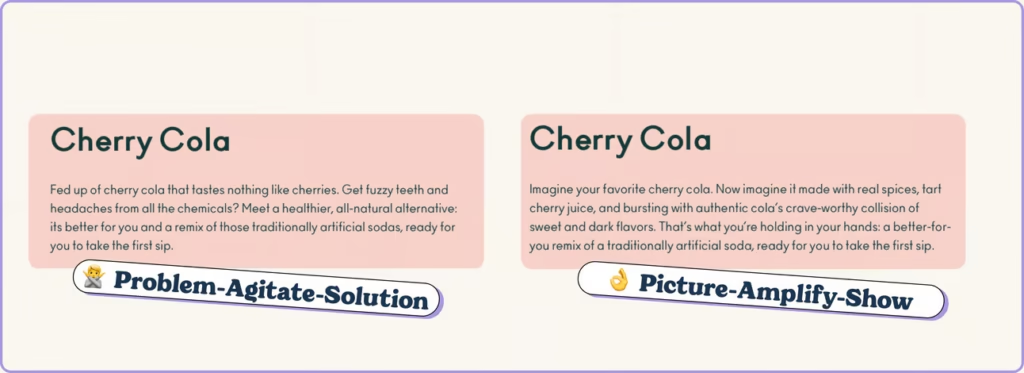
On the left is a version we edited to be negative framing. On the right, their version.
Not only do they keep all their copy focused on what the customer is gaining, but they also get to cheekily imply that other cherry colas are not made with real spices or real cherry juice without ever saying it. In other words, they’re agitating the problem of artificial flavourings without using negative language.
(Until the last sentence, which is a shame.)
Put this into action for your brand: try to use as much positive framing and empowering language in your copy as possible. Not only does it convert better in the short term, but it’s better for brand loyalty in the long run too.
Dive into more free tips and tricks 👇
How Starface use orthography to build a killer brand voice their customers love
The words you write matter. But so do your full stops, emojis and lowercase letters. Learn how to turn punctuation into a powerful part of your brand voice.
Why Oatly’s brand voice is so damn good (and how yours can be, too)
We dig into the three layers of brand voice (10,000ft, 1,000ft, ground level), show how Oatly nails each one and how you can do it for your own brand.
The weekly newsletter that takes your brand’s copy from “meh” to “hell f*cking yeah!”
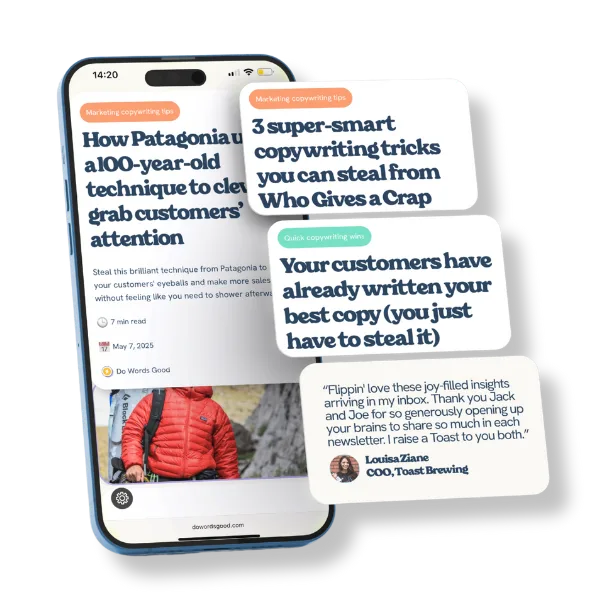
Read every week by legends at brands like these











